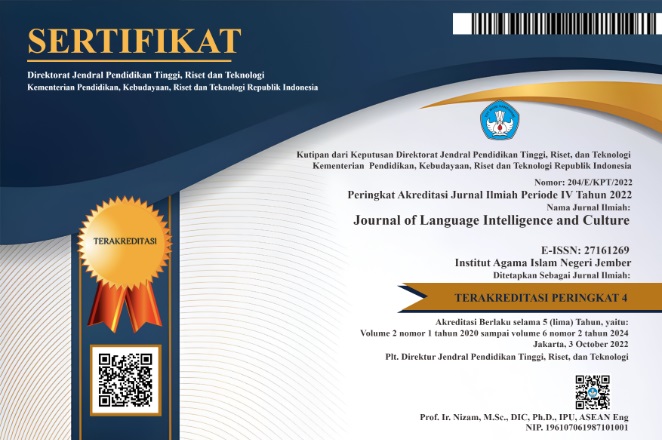The Contribution of Language Input, Conducive Learning Environment, and Motivation toward Student’s Speaking Proficiency
DOI:
https://doi.org/10.35719/jlic.v5i1.122Keywords:
language input, learning environment, motivation, speaking proficiencyAbstract
This study aimed to identify student’s speaking proficiency through the contribution of language input, conducive learning environment, and motivation. This research is qualitative study. Using a case study approach, the research sample consist of a single university student majoring in Business and Management, selected through purposive convenience sampling. Data was collected through interview, which explored student’s speaking ability, the availability of language input, learning environment, and student’s motivation. The findings reveal that the student demonstrated a good level speaking proficiency. Notably, subject's motivation affects her speaking proficiency more than the other aspects; language input and learning environment. Although the student’s exposure to language input is moderate, the learning environment is found as poor. To conclude, the three aspects of language learning: language input, learning environment, and motivation, affect student’s speaking proficiency. The outcomes portray the common experiences of Indonesian language learners as they acquire English as second language.
References
Bahrani, T. (2013). Importance of Language Input in Language Learning, 6(10), 1376-1379.
Basa, Irwan & Asrida, Deni & Fadli, Novria. (2018). CONTRIBUTING FACTORS TO THE STUDENTS’ SPEAKING ABILITY. Langkawi: Journal of The Association for Arabic and English. 3. 156. 10.31332/lkw.v3i2.588.
Budiharto, R. A., & Amalia, L. (2019). Motivation behind Indonesian undergraduates learning English as a target language. IDEAS: Journal on English Language Teaching and Learning, Linguistics and Literature, 7(1), 1- 14. https://doi.org/10.24256/ideas.v7i1.714
Domingo, Precious. (2019). Correlation between the Students’ English Language Proficiency and Their Exposure to English Language. SSRN Electronic Journal. 10.2139/ssrn.3462970.
Dulay, H., Burt, M., and Krashen, S. 1982. Language two. New York: Oxford University.
Frankel, Jack R. and Norman E. Wallen. (2012). How to Design and Evaluate in Research. New York: The McGraw-Hall .
Gardner, R. C. (2001). Integrative motivation and second language acquisition. In Z. Do?rnyei, & R. Schmidt (Eds.), Motivation and Second Language Acquisition (pp. 1-19). Hawaii: University of Hawaii Press.
Gijbels, D., Van De Watering, G., Dochy, F., & Van Den Bossche, P. (2006). New learning environments and constructivism: The students’ perspective. Instructional Science, 34, 213–226. https://doi.org/10.1007/s11251-005-3347- z
Krashen, S. D. (2002). Second language acquisition and second language learning. California: Pergamon Press Inc. Retrieved from http://www.sdkrashen.com/content/books/sl_acquisition_and_learning.pdf
M.Yan. 2022 . The Effect of Family Income on Parents’ Motivation. Hool et al. (Eds): ICHESS 2022, ASSEHR 720, pp. 2978-2985
Machebe, Chioma Henrietta; Ezegbe, Bernedeth N.; Onuoha, Joseph Universal Journal of Educational Research, v5 n9 p1614-1620 2017
Maharsi, I. (2016). The importance of input and interaction in second language acquisition. Journal of English and Education, 5(1), 45–53. https://doi.org/10.20885/jee.vol5.iss1.art4
Miles, B. M., & Huberman, A. M. (1994). Qualitative data analysis (Second Edi). SAGE
Ogunshola – Influence of Parental Income Position on Students’ Academic Performance in Public Senior Secondary Schools in Abuja Municipal Area Council, Nigeria, 2019, BSUJEM Vol.1, No. 1)
Opdenakker, M.-C., & Van Damme, J. (2006). Teacher characteristics and teaching styles as effectiveness enhancing factors of classroom practice. Teaching and Teacher Education, 22(1), 1–21. https://doi.org/10.1016/j.tate.2005.07.008
Pratiwi, A. W., Atmowardoyo, H., Salija, K. (2022). The Use of Indonesian in Teaching English as the Foreign Language. Journal of Art, Humanity, and Social Studies, 2(3), 57 – 66.
Rao, P. S. (2019). The Importance of Speaking Skills in Englishclassrooms. Alford Council of International English & LiteratureJournal(ACIELJ
Reutzel, D. R., & Cooter, R. B. (2004). Teaching Children to Read: Putting the Pieces Together (4th ed.). Merrill/Prentice-Hall Publishing Company.
Saunders, M; Lewis, P; Thornhill, A (2012). Research Methods for Business Students (6th ed.). Harlow: Pearson Education Ltd
Troike, Muriel, S. 2006. Introducing second language acquisition. Cambridge: Cambridge University Publications, Inc
Wang, X. (2010). Features of Input of Second Language Acquisition. Journal of Language Teaching and Research, 1(3), 282–284. https://doi.org/10.4304/jltr.1.3.282-284
Downloads
Published
How to Cite
Issue
Section
License
Copyright (c) 2023 Faida Azhimia, Tantry Ajeng Parnawati

This work is licensed under a Creative Commons Attribution-ShareAlike 4.0 International License.













